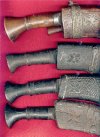Originally posted by John Powell
I have seen more than a few of these kukris and the patina is always the same and way too even, so I am just guessing, but they may be 'smoked' to look older.
This a very common style throughout Nepal and obviously looks very used. The wooden scabbard is actually easier to make than the leather covered ones so I would have to say it is just a regular villager from the mid 1900s and not worth a whole lot of money. Some of the better ones have much finer carving or slightly different details.
Even with all that, it is worth having at least one or two in a kukri collection to show just how hard working these things are.
John,
I really appreciate your evaluation. There is no question that you are probably the greatest khukuris expert in the world. I mean that with total respect.
I do have a few questions since I am really new at khuk understanding. You mentioned "smoked." It is my understanding that It is fairly standard village technology for a lot of old wood items to be coated with tree pitch. Wood buckets, old khuks, arrow quivers, ladders, woven baskets, etc. As I understand it this is supposed to prevent moisture rot, and boring insects, which will devour old wood. I could sure be wrong, but that seems to be the case here with this khuk.
Aren't there village khuks similar to this that are still in use by old timers in remote villages in Nepal, that looked about the same - with this dark, sometimes "crusty" sometimes smooth pitch coating on them? And this practice has been going on for hundreds of years.
I also want to understand better how to judge age on village khuks. The design also seems to be static for hundreds of years with mainly regional differences and I would like to know better how to judge the age more accurately. How can you tell a blade that is "mid nineteen hundreds" from one that is mid eighteen hundreds?
Lastly, I do appreciate it that you say "it is worth having one or two in every collection...."
Think that I may go back and do a little bidding. It has got to be worth more than $13.50!
I know the seller quite well and he is one of the most honorable people I have ever met.
Respectfully
Bill Marsh















